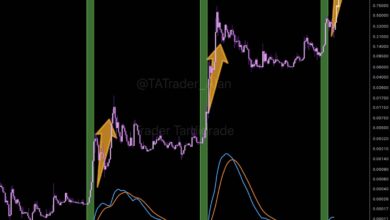
Bitcoin Price Stability Driven by Institutional ETFs and Geopolitical
Bitcoin (BTC) has stayed somewhat consistent at roughly $94,000 as of April 28, 2025. This stability coexists with an unstable global trade environment marked by growing geopolitical concerns and economic volatility upsetting established financial markets. But the ongoing flood of institutional investments—especially via Bitcoin Exchange-Traded Funds (ETFs)—has given the digital asset the tools it needs to withstand these stormy times.
Institutional Investors and Bitcoin
One cannot stress the part institutional investors play in the current rise in the price of Bitcoin. Large financial firms now have a portal, thanks to ETFs, to expose themselves to Bitcoin free from the complications of direct ownership. Institutions can escape the difficulties of managing the infrastructure needed for owning and trading cryptocurrencies straight by investing in Bitcoin ETFs, therefore avoiding the problems with private key security.

Attracting significant inflows since its introduction, BlackRock’s iShares Bitcoin Trust (IBIT) has been among the most outstanding products in this market. Over record time, the fund has shown amazing expansion, exceeding $50 billion in assets under control. This degree of institutional support shows that some of the biggest financial companies in the world are progressively seeing Bitcoin as a respectable and safe investment class. Other asset management behemoths, such as Fidelity and ARK Invest, have also started their own Bitcoin ETFs as Bitcoin ETFs acquire more popularity, hence expanding institutional participation in the market.
The great success of these Bitcoin ETFs shows a growing conviction about the long-term possibilities of Bitcoin. Because of its restricted quantity and distributed character, unlike conventional investment vehicles, Bitcoin appeals as an inflation hedge. Bitcoin’s deflationary qualities help to offset currency devaluation as central banks keep implementing lax monetary policies and government spending increases, therefore offering a tempting substitute for more conventional assets like equities and bonds.
Bitcoin Price Drivers
Global trade uncertainties have also played a crucial role in Bitcoin’s price stability. Tensions between the United States and China have created significant volatility in traditional financial markets, with stock markets showing unpredictable fluctuations and concerns over global economic slowdown. Amid this turmoil, Bitcoin has increasingly been seen as a safe-haven asset—much like gold—capable of preserving value during periods of economic stress.
In addition to geopolitical tensions, concerns over inflation have also been a key driver of Bitcoin’s appeal. As central banks in major economies, including the Federal Reserve, continue their accommodative monetary policies, inflation fears have escalated. Bitcoin’s fixed supply of 21 million coins makes it immune to the kind of inflationary pressures that affect fiat currencies. This feature has led to growing institutional interest in Bitcoin, especially from those seeking a way to hedge against rising costs of living and depreciating currencies.
Furthermore, Bitcoin has benefitted from its growing adoption as a form of wealth preservation in regions facing political or economic instability. In countries with high inflation or a lack of faith in local currencies, Bitcoin is increasingly seen as a more reliable store of value, which is helping to support its price globally.
Bitcoin ETF Growth
The ongoing inflow into Bitcoin ETFs highlights the increasing confidence in Bitcoin as a legitimate asset class. According to recent reports, Bitcoin ETFs collectively manage tens of billions of dollars, with some estimates suggesting that Bitcoin could see over $100 billion in ETF inflows by the end of 2025. This surge in institutional demand is providing crucial liquidity and stability to the Bitcoin market.

A major benefit of Bitcoin ETFs is that they allow for greater liquidity compared to the often-volatile spot market. This is particularly attractive to institutional investors who prioritize stability and predictable returns. As more ETFs enter the market, the infrastructure surrounding Bitcoin trading continues to mature, making it easier for large institutions to participate without the concerns typically associated with cryptocurrency investments.
Moreover, the growing regulatory clarity around Bitcoin and ETFs is contributing to the market’s maturation. While some countries remain cautious about the cryptocurrency space, many financial regulators in Europe and North America have started to embrace Bitcoin ETFs as a way to provide safe, regulated access to the asset. This regulatory acceptance is helping to assuage the concerns of institutional investors, who were once wary of entering a market that lacked oversight.
Final thoughts
The present price of Bitcoin, roughly $94,000, illustrates a dynamic confluence of elements, with stability mostly dependent on institutional interest. The emergence of Bitcoin ETFs has given the required infrastructure for big investments, therefore enabling Bitcoin to become a major asset class in the financial sector. Combined with Bitcoin’s function as a market volatility and inflation hedge, it seems destined to keep on its increasing path.
Looking ahead, Bitcoin’s capacity to negotiate worldwide trade uncertainty and economic issues will mostly rely on continuous institutional adoption, the legal environment, and its increasing acceptance as a valid store of value. With institutions pouring money into the Cryptocurrency Market and Bitcoin ETFs gathering pace, the future of the coin seems bright with possibility for steady price development. Bitcoin is probably going to be front and foremost as the digital asset market develops, drawing institutional and ordinary investors alike.







